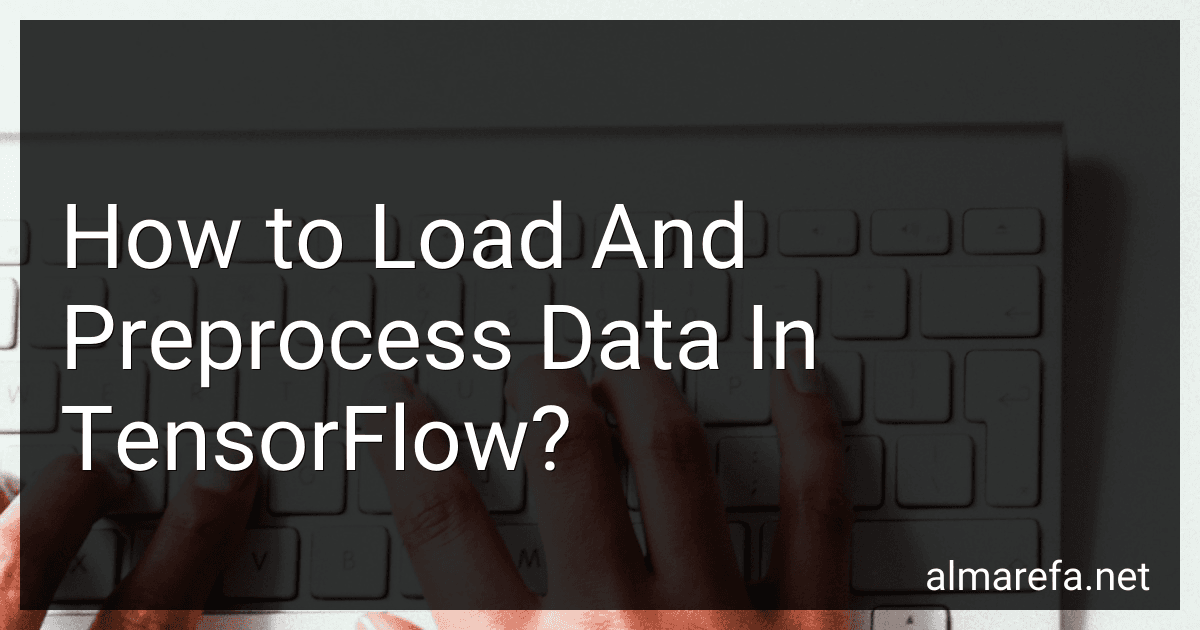almarefa.net
-
 5 min readLoading and preprocessing data is an essential step in training machine learning models using TensorFlow. Here's an overview of how you can accomplish this:Import the necessary libraries: Import TensorFlow: import tensorflow as tf Import other necessary libraries like NumPy, Pandas, etc. Load the data: TensorFlow provides multiple ways to load data, such as using the tf.data.Dataset API, reading from files directly, or using third-party libraries like NumPy or Pandas.
5 min readLoading and preprocessing data is an essential step in training machine learning models using TensorFlow. Here's an overview of how you can accomplish this:Import the necessary libraries: Import TensorFlow: import tensorflow as tf Import other necessary libraries like NumPy, Pandas, etc. Load the data: TensorFlow provides multiple ways to load data, such as using the tf.data.Dataset API, reading from files directly, or using third-party libraries like NumPy or Pandas.
-
 8 min readTo create a basic neural network in TensorFlow, follow these steps:Import the necessary libraries: You need to import TensorFlow and any other libraries you may need for data processing and visualization. Preprocess the data: Prepare your data by performing any required preprocessing steps such as normalization, encoding categorical variables, or splitting into training and testing sets. Define the model architecture: Create a Sequential model, which is a linear stack of layers in TensorFlow.
8 min readTo create a basic neural network in TensorFlow, follow these steps:Import the necessary libraries: You need to import TensorFlow and any other libraries you may need for data processing and visualization. Preprocess the data: Prepare your data by performing any required preprocessing steps such as normalization, encoding categorical variables, or splitting into training and testing sets. Define the model architecture: Create a Sequential model, which is a linear stack of layers in TensorFlow.
-
 5 min readmultiplying tensors in tensorflow can be done using the tf.matmul() function. This function performs matrix multiplication on two tensors, assuming that both tensors have compatible dimensions. The dimensions of the input tensors must satisfy the matrix multiplication requirements, which means the inner dimensions must match. For instance, if you have two tensors A with shape (m, n) and B with shape (n, p), where m, n, and p represent the dimensions, you can multiply them using tf.matmul(A, B).
5 min readmultiplying tensors in tensorflow can be done using the tf.matmul() function. This function performs matrix multiplication on two tensors, assuming that both tensors have compatible dimensions. The dimensions of the input tensors must satisfy the matrix multiplication requirements, which means the inner dimensions must match. For instance, if you have two tensors A with shape (m, n) and B with shape (n, p), where m, n, and p represent the dimensions, you can multiply them using tf.matmul(A, B).
-
 4 min readTo get the current available GPUs in TensorFlow, you can use the tensorflow.test.is_gpu_available() function. This function returns True if GPU support is available and False otherwise.If you want more detailed information about the available GPUs, you can use the tensorflow.config.experimental.list_physical_devices('GPU') function. This function returns a list of PhysicalDevice objects representing the available GPUs.
4 min readTo get the current available GPUs in TensorFlow, you can use the tensorflow.test.is_gpu_available() function. This function returns True if GPU support is available and False otherwise.If you want more detailed information about the available GPUs, you can use the tensorflow.config.experimental.list_physical_devices('GPU') function. This function returns a list of PhysicalDevice objects representing the available GPUs.
-
 5 min readIn TensorFlow, you can use indexing to access specific rows of a tensor. The indexing operation allows you to extract or modify specific elements, slices, or subtensors of a tensor.To get specific rows of a tensor, you can use the bracket notation with the desired row numbers inside the brackets. Here's how you can do it:Create a tensor: import tensorflow as tf tensor = tf.
5 min readIn TensorFlow, you can use indexing to access specific rows of a tensor. The indexing operation allows you to extract or modify specific elements, slices, or subtensors of a tensor.To get specific rows of a tensor, you can use the bracket notation with the desired row numbers inside the brackets. Here's how you can do it:Create a tensor: import tensorflow as tf tensor = tf.
-
 4 min readIn TensorFlow, you can set specific elements of a tensor using various functions and operations. Here are some approaches to set tensor elements in TensorFlow:Using tf.Variable: Create a TensorFlow variable and assign it to the tensor. Then, use the variable's assign() method to modify specific elements. import tensorflow as tf # Create a tensor tensor = tf.Variable([[1, 2, 3], [4, 5, 6]]) # Create an assignment operation assign_op = tf.
4 min readIn TensorFlow, you can set specific elements of a tensor using various functions and operations. Here are some approaches to set tensor elements in TensorFlow:Using tf.Variable: Create a TensorFlow variable and assign it to the tensor. Then, use the variable's assign() method to modify specific elements. import tensorflow as tf # Create a tensor tensor = tf.Variable([[1, 2, 3], [4, 5, 6]]) # Create an assignment operation assign_op = tf.
-
 7 min readTo train parallel layers in TensorFlow, we can use the concept of parallelism in TensorFlow's computational graph. The parallelism can be achieved by implementing multiple layers in parallel and sharing the data flow between them. Here is a general approach to train parallel layers in TensorFlow:Design the Model: Define the architecture of the model with multiple parallel layers. Each layer can have its own set of variables and operations.
7 min readTo train parallel layers in TensorFlow, we can use the concept of parallelism in TensorFlow's computational graph. The parallelism can be achieved by implementing multiple layers in parallel and sharing the data flow between them. Here is a general approach to train parallel layers in TensorFlow:Design the Model: Define the architecture of the model with multiple parallel layers. Each layer can have its own set of variables and operations.
-
 6 min readIn TensorFlow, you can fetch specific rows from a tensor using indexing. Indexing allows you to access specific elements or subsets of elements in a tensor.To fetch specific rows from a tensor, you need to use the indexing syntax provided by TensorFlow. Here's how you can do it:Import the TensorFlow library: import tensorflow as tf Create a tensor: tensor = tf.constant([[1, 2, 3], [4, 5, 6], [7, 8, 9]]) Define the rows you want to fetch.
6 min readIn TensorFlow, you can fetch specific rows from a tensor using indexing. Indexing allows you to access specific elements or subsets of elements in a tensor.To fetch specific rows from a tensor, you need to use the indexing syntax provided by TensorFlow. Here's how you can do it:Import the TensorFlow library: import tensorflow as tf Create a tensor: tensor = tf.constant([[1, 2, 3], [4, 5, 6], [7, 8, 9]]) Define the rows you want to fetch.
-
 6 min readLoading CSV files in a TensorFlow program involves several steps:Import the required libraries: Begin by importing the necessary libraries like TensorFlow and pandas. Read the CSV file: Use the pandas library to read the CSV file into a pandas DataFrame. For example: import pandas as pd df = pd.read_csv('file.csv') Extract features and labels: If your CSV file contains both features and labels, you need to separate them.
6 min readLoading CSV files in a TensorFlow program involves several steps:Import the required libraries: Begin by importing the necessary libraries like TensorFlow and pandas. Read the CSV file: Use the pandas library to read the CSV file into a pandas DataFrame. For example: import pandas as pd df = pd.read_csv('file.csv') Extract features and labels: If your CSV file contains both features and labels, you need to separate them.
-
 11 min readIn TensorFlow, you can save the essential parameters of a model by specifying which variables to save. This can be useful when you have a large model with many variables, but you only need to save a subset of them. By saving only the essential parameters, you can reduce the size of the saved model and simplify future loading and deployment processes.
11 min readIn TensorFlow, you can save the essential parameters of a model by specifying which variables to save. This can be useful when you have a large model with many variables, but you only need to save a subset of them. By saving only the essential parameters, you can reduce the size of the saved model and simplify future loading and deployment processes.
-
 7 min readTo load CSV files in a TensorFlow program, you can follow these steps:Import the necessary libraries: import tensorflow as tf import numpy as np Define the function to parse the CSV records. Specify the input columns and their corresponding data types: def parse_csv(line): columns = tf.io.decode_csv(line, record_defaults=[tf.float32] * num_features) features = tf.stack(columns[:-1]) label = tf.
7 min readTo load CSV files in a TensorFlow program, you can follow these steps:Import the necessary libraries: import tensorflow as tf import numpy as np Define the function to parse the CSV records. Specify the input columns and their corresponding data types: def parse_csv(line): columns = tf.io.decode_csv(line, record_defaults=[tf.float32] * num_features) features = tf.stack(columns[:-1]) label = tf.